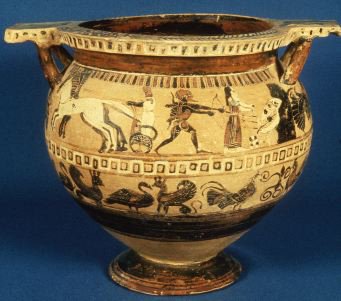What Was the Monster of Troy?
I Corinthians 12:2
“Ye know that ye were Gentiles, carried away unto these dumb idols, even as ye were led.”
While the word “fossil” is a modern term, people thousands of years ago may have known about fossils. If they did, they didn’t know what fossils were. That’s the new theory proposed by a group that includes a folklorist and some paleontologists. Their theory is based on the figures painted on a 2,500 year old Corinthian vase.
 The colorful vase was made about 550 B.C. Called the Hesione vase; it shows the mythical woman, Hesione, being rescued from the monster of Troy by the Greek hero Herakles. Only the monster’s head is shown emerging from a cave. The head looks very much like a giant skull with a tongue and a lizard like eye socket. Those behind the new theory conclude that these details were added to what was really a very common fossil in the area. The monster was evidently perceived as a sea serpent. However, paleontologists say that the area around the Aegean Sea and western Turkey contains many fossils of large giraffes, camels and horses. Sometimes these fossils become exposed as the rocky hillsides weather. When the ancient Greeks found these large fossils, they thought that they were the bones of gods and monsters.
The colorful vase was made about 550 B.C. Called the Hesione vase; it shows the mythical woman, Hesione, being rescued from the monster of Troy by the Greek hero Herakles. Only the monster’s head is shown emerging from a cave. The head looks very much like a giant skull with a tongue and a lizard like eye socket. Those behind the new theory conclude that these details were added to what was really a very common fossil in the area. The monster was evidently perceived as a sea serpent. However, paleontologists say that the area around the Aegean Sea and western Turkey contains many fossils of large giraffes, camels and horses. Sometimes these fossils become exposed as the rocky hillsides weather. When the ancient Greeks found these large fossils, they thought that they were the bones of gods and monsters.
While this may seem superstitious to us today, we should be careful. Today’s great superstition is that life evolved from non living matter over millions of years. Belief in evolution is no less an attempt to escape acknowledging our Creator God than the legends of the ancient Greek gods. St. Paul himself wrote that the eternal power and divine nature of God are evident through the creation.
Prayer:
Dear Father, I thank You for the light of Your Word. Amen.
Notes:
Science News, 2/26/00, p. 133, “Vase shows that the ancients dug fossils, too.” Photo: Hesione vase. Photo source: unknown.